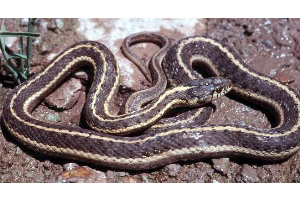In some parts of its range, this snake has rear, upper, jaw teeth that are long and bladelike that can be used to impale, hold, and manipulate prey.
Photo Credit: Geoffrey A. Hammerson
Thamnophis elegans
Common Name: western terrestrial garter snake
Other Common Names: terrestrial gartersnake
Animal Guild: Reptile
Class > Order > Family: Reptilia > Squamata > Colubridae
